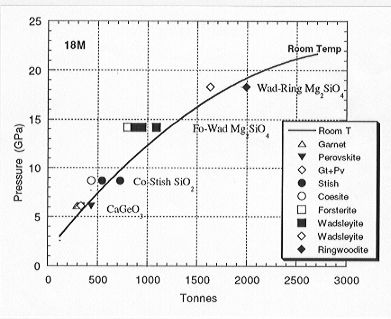

Pressure calibration of a 6-8 type multianvil apparatus is now underway
following the recent installment of a 5000-tonne uniaxial press. The press
frame is 5 meters in height, over 60 tonnes in weight and houses a 960
mm diameter ram with a travel distance of 200 mm. Six outer anvils are
contained within a split cylinder geometry to create a working volume for
eight 54 mm cubic inner anvils made of tungsten carbide. Phase transitions
in silicates, metals and semiconductors were used to calibrate 18-mm (18M)
and 25-mm (25M) edge-length MgO octahedra using 11-mm and 17-mm truncation
edge lengths (TEL) on the tungsten carbide anvils, respectively. Calibration
of the 18M assembly (Fig. 3.8-1) using 5 x 3 mm pyrophyllite gaskets was
carried out at room temperature up to the GaP semiconductor to metal transition
at 22 GPa and required 2660 tonnes. Pressure generation from the Bi I-II
(2.55 GPa) to the Bi III-V (7.7 GPa) is very efficient with applied force,
but efficiency decreases at higher pressures (ZnS at 15.6 GPa, GaAs at
18.3 GPa and GaP at 22 GPa). High-temperature (1000-1200°C) calibrations
have been carried out for the same assembly up to the wadsleyite-ringwoodite
transition at 18 GPa, which required about 2000 tonnes. For the high-temperature
calibration, pressure efficiency was better than at room temperature, beginning
with the CaGeO3 (Gt-Pv) transition at 6 GPa, and continuing
with coesite-stishovite at 9 GPa and forsterite-wadsleyite at 14 GPa, but
curvature was evident in the pressure vs. load plot approaching the wadsleyite-ringwoodite
transition at 18 GPa. Optimization of gasket composition and dimensions
may improve efficiency at these higher applied loads. These results provide
encouragement that it will be possible to increase sample volumes to the
sizes necessary for in situ measurements of physical properties such as
thermal conductivity and ultrasonic-wave velocity, on high-pressure phases
such as ringwoodite and perovskite.
 |

Tel: +49-(0) 921 55 3700 / 3766, Fax: +49-(0) 921 55 3769, E-mail: bayerisches.geoinstitut(at)uni-bayreuth.de
 Previous page
Previous page